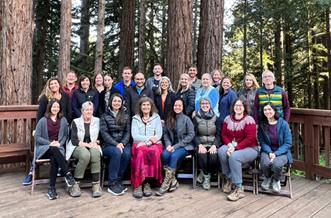June 2023 Newsletter: Adventures and Opportunities
Hello!
| I hope your summer is off to a happy and healthy start. My spring was busy, with work and personal events from coast to coast. I have more adventures planned for this year and next. Get in touch if you might like to join me on a possible August 1-7, 2023 hiking trip Mt Assiniboine lodge high in the Canadian Rockies; an easy trek near the Annapurna region of Nepal in December of either 2023 or 2024; or a snorkeling trip (with possible diving) amidst the rich undersea reefs of Raja Ampat in West Papua, Indonesia in November 2024.
I spent the last week of March in Alaska, where I skied and lectured for Alaska Community Action on Toxics (ACAT). ACAT leads local research projects to help protect Alaska native communities from chemical harm. Flame retardants, PCBs, and other persistent chemicals move north with the winds and the waves and end up in local food supplies. Consequently, Alaska natives have among the highest levels of toxics exposures on our planet. Please consider supporting ACAT’s impactful community scientific research to stop this grave environmental injustice. In April, we held our Institute’s Tenth Anniversary Six Classes Toxics Reduction Retreat in the Santa Cruz mountains. This year we focused on big ideas towards a healthier world such as reducing toxic pollution, climate change and plastic pollution as critical sustainability goals. May took me to New York City, where I was honored to give a talk on stopping the use of PFAS at the Sustainable Cosmetics Summit, attended by senior executives in the beauty industry. Many had not previously known that PFAS in personal care products have been banned in California and other U.S. states. This spring also saw the publication of important research papers by our Institute scientists and colleagues. Each received extensive media coverage (see links in the In the News section below) thanks to our communications strategy:
On a different topic, I recently had the pleasure of helping move one of my favorite creatures, a California dusky footed woodrat we nicknamed Woody, from my neighbor’s woodshed to a nearby wild area inhabited by other woodrats. See below for more about these very industrious and cute rodents. Have a fun summer, P.S. Here are two opportunities in Berkeley: Warm regards, Arlene |
Woody Returns to the WoodsWalking familiar trails in Berkeley’s Tilden Park, a friend pointed out mysterious large structures woven of branches. Some were as large six feet by six feet and we could not imagine what could’ve made them. No beavers in the area. Birds? Yetis? The answer is the very industrious and cute California dusky-footed woodrat. Please read on for short excerpts from Michael Ellis’s great article about these small and very nocturnal creatures in Bay Nature and consider signing up for a subscription to this informative publication for outdoor-lovers: “The nests of these extremely hard-working small rodents can be as large as a Volkswagen bug and last for decades. Woodrats are sometimes called pack rats because they love to collect and store various kinds of junk… Folks living near these critters have reported missing shoes, lace curtains, soap, and wallpaper!” “A woodrat nest may look like an enormous haphazard pile of sticks and leaves from the outside, but inside is a carefully designed and organized forest home. Like us humans, woodrats have very particular requirements for their homes. Not too dry or too wet… Goldilocks with whiskers!” |
We All Scream for SunscreenWith summer approaching, those of us who love being outdoors are looking for effective sunscreens that do not contain harmful ingredients. However, finding healthy and functional sunscreens can be challenging. Starting with some good news: the use of Oxybenzone, known to be harmful to humans as well as to coral reefs, was found in 15% of sunscreens on the market in the U.S. in 2022. This decreased to 6%. This marks good progress! You can find suggestions for recommended sunscreen without harmful ingredients at: – Environmental Working Group (EWG) Guide to Sunscreens – The New York Times Wire Cutter Review of Best Sunscreen – Surfrider Foundation Guide to Reef Friendly Sunscreens Surfrider, a nonprofit focused on healthy reefs and oceans, makes the following recommendations: 1. Check the label. Make sure your sunscreen does not contain the following harmful substances on the HEL list: Oxybenzone, Octinoxate, Octocrylene, 4-methylbenzylidene camphor, PABA, Parabens, Triclosan, any sort of microplastic, such as “exfoliating beads,” nanoparticles, or “nano-sized” zinc or titanium. A good friend who leads the Surfrider Foundation in Kauai, Hawaii shared her strategy: “I am concerned about the ingredients in sunscreens so I usually wear big hats and long-sleeved shirts and stay out of the midday sun. Also, Vitamin D from the sun is healthy—so I am happy to get daily sun exposure.” |
Restricted Flame Retardants in Baby Toys & MoreBy Lydia Jahl One of the most sobering aspects of keeping up with environmental health research is learning when harmful chemicals are used in consumer products. On the other hand, this knowledge can empower consumers to make smarter purchasing decisions and prompt policymakers to act. Unfortunately, this progression of research → communication → action falls through when chemicals that are already banned still end up in products. That is exactly what occurred when researchers detected chlorinated paraffin chemicals in 84 out of 96 tested Canadian products. These chemicals, used as flame retardants, plasticizers, and more, are persistent, bioaccumulative, and toxic. Some of the highest levels of chlorinated paraffins were found in plastic baby toys–especially concerning because toddlers often put toys in their mouths and eat with their hands. High concentrations were also found in electronics, such as the outer plastic sheaths of a computer wire and a headphone wire – remember not to mindlessly chew on your headphone wires, and wash your hands before eating to reduce your exposure chlorinated paraffins and other harmful chemicals. The presence of these chemicals in consumer products despite current restrictions is unsettling to the point that the authors called for “concerted and coordinated international efforts to stem their production and international trade.” CPs are less-studied than legacy flame retardants like PBDEs, but a few recent papers have confirmed their widespread contamination with detections in Japanese children’s toys, tea & tea packaging, instant noodles, and recycled car tire products. Here at the Institute, we will continue to examine chlorinated paraffins as well as other less-studied flame retardants like PolyFR. And as always, we encourage our readers to vote with your dollar by purchasing healthier, plastic-free products and vote for candidates who support health and environment. |
Popular COVID Disinfectants Harmful and Often Unnecessaryby Rebecca Fuoco The COVID-19 pandemic has increased the unnecessary use of harmful antimicrobial chemicals, warns a new paper by more than two dozen authors (including our Institute’s Anna Soehl, Carol Kwiatkowski, and Arlene Blum). Their critical review details how quaternary ammonium compounds (QACs) are increasingly marketed and used in home, healthcare, education, and workplace settings despite the availability of safer alternatives and in some cases limited evidence of reduced disease transmission. Zealous spraying and wiping of surfaces with QACs continues in schools and workplaces, even as the pandemic recedes. When disinfection is needed, safer products are available. What’s at stake? Human studies have found associations between some QACs and asthma, dermatitis, and inflammation. Laboratory animal studies also raise concerns about potential links to infertility, birth defects, and more. Further, evidence dating back to the 1950s suggests that QACs contribute to antimicrobial resistance, making certain bacteria species resistant both to QACs themselves and to critical antibiotics. Benzalkonium chloride is a common QAC and others can be identified on ingredient labels with names that end in “-onium chloride” or similar. However, disclosure and regulation of QACs varies widely. The scientists recommend eliminating uses of QACs that are either unnecessary or where their effectiveness has not been demonstrated. For example, disinfection with QACs often has no benefit over cleaning with plain soap and water. “Reducing the use of QACs won’t spread COVID-19,” says Carol. “In fact, it will make our homes, classrooms, offices, and other shared spaces healthier.” |
PFAS in the Garden? How to Minimize Exposureby Kris Hansen Does the beginning of spring find you looking forward to planting vegetables or berry bushes in your home garden? In addition to thinking about garden pests and challenging weather, are you concerned about PFAS exposure? I live in Minnesota adjacent to areas where PFAS were landfilled for years and groundwater is contaminated. Being thoughtful about how you plant and care for your garden, especially in a community like mine, can ensure that contamination of your homegrown produce is unlikely to pose a problem. PFAS in homegrown vegetables can come from PFAS contaminated water, soil, or compost made from contaminated biosolids. See below for suggestions to minimize PFAS in your homegrown harvest if you live near a source of PFAS: ● In general, long chain PFAS (e.g. PFOS, PFOA) are less likely to be present in the leafy, above ground portion of your vegetables. Smaller chain PFAS (e.g. PFBS) are more water soluble and have high bioavailability so they can more easily travel throughout the plants, including the edible greens. |
Green Science Policy Institute in the Newsby Rebecca Fuoco Below are recent news articles, blogs, podcasts, newsletters, and more that have featured Arlene’s work based on our communications strategy:
|






